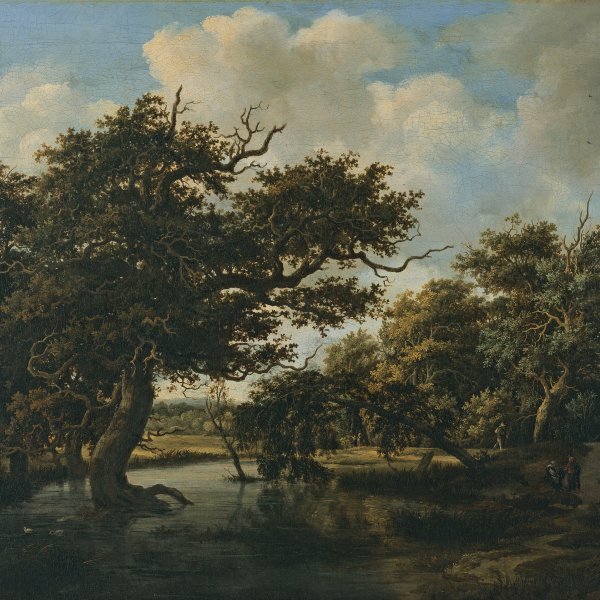Meindert Lubbertsz. Hobbema
Amsterdam, 1638-1709
This artist was baptised in Amsterdam as Meindert Lubbertsz., but from an early age used the additional name of Hobbema. At the age of fifteen he and his brothers were taken into care by the municipal orphanage in Amsterdam. After spending two years there he entered the studio of Jacob van Ruisdael where he trained as a painter. Hobbema’s first work as an independent master, River View (Detroit Institute of Arts) is dated 1658, painted when Hobbema was aged twenty. His early paintings reveal the influence of his master as well as that of Cornelis Vroom and Salomon van Ruysdael. Around 1662 the influence of Jacob van Ruisdael became so pronounced that it could be said that Hobbema’s paintings were exact copies of his teacher’s motifs and compositions. This was a short-lived period, however, and Hobbema soon began to develop his own artistic personality. He favoured depictions of forests with broad, deep spatial settings and used a more luminous, colourful palette than his master, also preferring to work on a larger scale. This period, from 1663 to 1668, was the most productive of his career.
In October 1668 Hobbema married Eeltje Pieters Vinck, at which ceremony Ruisdael was a witness. That same year he worked as municipal Customs Inspector in Amsterdam, a position he retained for the rest of his life. For many years it was thought that his marriage and new position encouraged Hobbema to completely abandon painting but the discovery of various works with dates later than 1668 indicates that this was not the case, although his output considerably diminished from then on. Avenue of Trees in Middelharnis (National Gallery, London) of 1689, which is his best known work from his late phase, introduces a new theme, that of a landscape modified by the hand of man in which symmetry, order and beauty prevail over fields that have been laid out for sowing, divided by paths and carefully planted trees.
In October 1668 Hobbema married Eeltje Pieters Vinck, at which ceremony Ruisdael was a witness. That same year he worked as municipal Customs Inspector in Amsterdam, a position he retained for the rest of his life. For many years it was thought that his marriage and new position encouraged Hobbema to completely abandon painting but the discovery of various works with dates later than 1668 indicates that this was not the case, although his output considerably diminished from then on. Avenue of Trees in Middelharnis (National Gallery, London) of 1689, which is his best known work from his late phase, introduces a new theme, that of a landscape modified by the hand of man in which symmetry, order and beauty prevail over fields that have been laid out for sowing, divided by paths and carefully planted trees.





